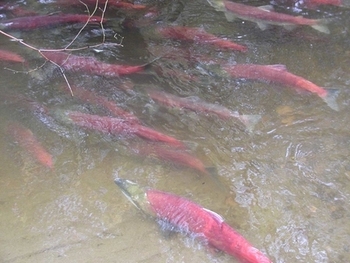‘Salmon SEEson’ returns: Where to spot fish as they come home to spawn in King County rivers and streams
Summary
Salmon are returning home to spawn in King County’s rivers and streams – find details on self-guided and interpretive fish-viewing opportunities on the Salmon SEEson website.
Story

Pacific salmon – including sockeye, Chinook, coho, and chum – are making the journey from the open ocean to their birthplaces to spawn in streams and rivers that feed into Puget Sound. Lake Sammamish kokanee, which are landlocked sockeye salmon that spend their entire lives in freshwater and have seen strong returns in recent years, will soon move into streams along the lake to spawn.
The Salmon SEEson program helps people witness the amazing migration salmon make each late summer and fall at locations across King County.
Find viewing locations as well as virtual viewing opportunities on the Salmon SEEson website. These salmon-viewing locations offer the best chances of seeing salmon.
Some sites are self-guided, while other locations have opportunities to interact with volunteer naturalists on specific dates to help visitors spot fish and learn about the salmon’s lifecycle and efforts to protect and restore salmon habitat.
Each year, the Muckleshoot Indian Tribe and Washington Department of Fish and Wildlife count the number of salmon returning through the Ballard Locks fish ladder from mid-June to early October. Sockeye typically migrate through the Ballard Locks from May to August, followed by Chinook from July to September, and coho from late August to November.
In recent years, sockeye numbers have declined substantially in the watershed. Chinook returns remain well below population recovery goals. Lake Sammamish’s native kokanee population has been in decline for the last few decades, and King County and partners continue to take actions to avoid possible extinction – with some promising results.
Salmon are sensitive to the changing climate, including warmer water temperatures that stress the fish and can increase their susceptibility to disease and increased predator metabolism and consumption of juveniles as they migrate out to saltwater in Puget Sound and the Pacific Ocean.
Salmon are a Pacific Northwest icon and a vital cultural, economic, and environmental resource for our region. Local governments and community groups around King County and Puget Sound are working to recover salmon populations by protecting and restoring habitat, managing stormwater runoff from streets and other hard surfaces, and educating the public about what they can do to help.
Working to recover salmon is about more than salmon – it is fundamentally about caring for our home and making our communities sustainable for the long-term. Protecting and restoring salmon habitat also improves water quality, reduces flood hazards, protects open space, helps manage stormwater, sustains and improves our quality of life.
Practicing water conservation and pollution prevention year-round helps salmon thrive, which means more fish can survive and continue their journey to the ocean and back to local streams and rivers.
Salmon SEEson is sponsored by the WRIA 8 Salmon Recovery Council as part of its effort to recover salmon in the Lake Washington/Cedar/Sammamish Watershed, known as WRIA 8. Additional sponsors include the Saving Water Partnership, Duwamish Alive Coalition, the Green/Duwamish and Central Puget Sound Watershed, the Snoqualmie Watershed Forum, and King County.
For more information, visit the Salmon SEEson website.
RELEVANT LINKS
• Salmon SEEson website
• WRIA 8 watershed salmon recovery website
• Learn about salmon recovery work in King County
FOR MORE INFORMATION, CONTACT:
Doug Williams, Department of Natural Resources and Parks, 206-477-4543

 Translate
Translate